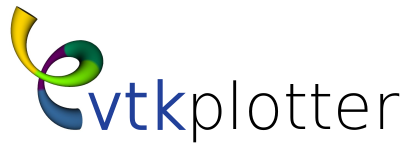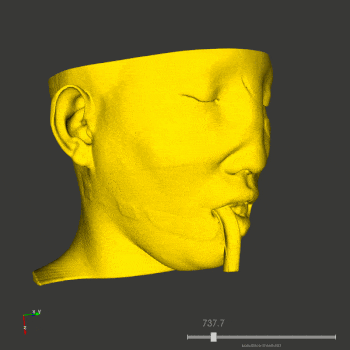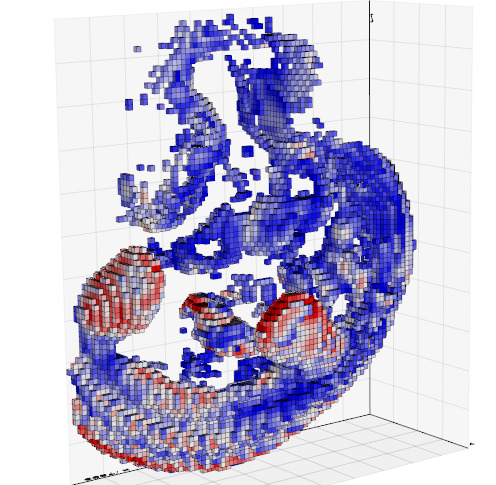A pure python module for scientific visualization, analysis and animation of 3D objects
and point clouds based on VTK and numpy.
Use pip to install:
pip install vtkplotterAutomatically generated documentation can be found here.
Intuitive and straightforward API which can be combined with VTK seamlessly in a program, whilst mantaining access to the full range of VTK native classes.
It includes a large set of working examples for all the following functionalities:
- Import meshes from VTK format, STL, Wavefront OBJ, 3DS, XML, Neutral, GMSH, OFF, PCD (PointCloud), volumetric TIFF stacks, DICOM, SLC, MHD, 2D images PNG, JPEG.
- Export meshes as ASCII or binary to VTK, STL, OBJ, PLY formats.
- Mesh analysis through the built-in methods of VTK package. Additional analysis tools like Moving Least Squares, mesh morphing.
- Tools to visualize and edit meshes (cutting a mesh with another mesh, slicing, normalizing, moving vertex positions, etc..). Interactive cutter widget.
- Split mesh based on surface connectivity. Extract the largest connected area.
- Calculate mass properties, like area, volume, center of mass, average size etc.
- Calculate vertex and face normals, curvatures, feature edges. Fill mesh holes.
- Subdivide faces of a mesh, increasing the number of vertex points. Mesh simplification.
- Coloring and thresholding of meshes based on associated scalar or vectorial data.
- Point-surface operations: find nearest points, determine if a point lies inside or outside a mesh.
- Create primitive objects like: spheres, arrows, cubes, torus, ellipsoids...
- Generate glyphs (associating a mesh to each vertex of a source mesh).
- Create animations easily by just defining the position of the displayed objects in the 3D scene. Add trailing lines and shadows to moving objects is also supported.
- Straightforward support for multiple sync-ed or independent renderers in the same window.
- Registration (alignment) of meshes with different techniques.
- Mesh smoothing with Laplacian and WindowedSinc algorithms.
- Delaunay triangulation in 2D and 3D.
- Generate meshes by joining nearby lines in space.
- Find the closest path from one point to another, travelling along the edges of a mesh.
- Find the intersection of a mesh with a line (or with another mesh).
- Analysis of Point Clouds:
- Moving Least Squares smoothing of 2D, 3D and 4D clouds
- Fit lines, planes and spheres and ellipses in space
- Identify outliers in a distribution of points
- Decimate a cloud to a uniform distribution.
- Basic histogramming and function plotting in 1D and 2D.
- Interpolate scalar and vectorial fields with Radial Basis Functions and Thin Plate Splines.
- Analysis of volumetric datasets:
- Isosurfacing of volumes
- Direct maximum projection rendering
- Generate volumetric signed-distance data from an input surface mesh
- Probe a volume with lines and planes
- Generate stream-lines and stream-tubes from vectorial fields
- Add sliders and buttons to interact with the scene and the individual objects.
- Fully customizable axis style.
- Draw
latex-formatted formulas on the rending window. - Examples using SHTools package for spherical harmonics expansion of a mesh shape.
- Integration with the Qt5 framework.
- Support for FEniCS/Dolfin platform for visualization of finite-element calculations.
- Visualization of tensors.
- Export a 3D scene and embed it into a web page.
- Embed the 3D rendering in a jupyter notebook with K3D (can export an interactive 3D-snapshot page here).
- Interoperability with the trimesh library.
Visualize a mesh with:
vtkplotter mesh.obj
# valid formats: [vtk,vtu,vts,vtp,vtm,ply,obj,stl,3ds,dolfin-xml,neutral,gmsh,
# pcd,xyz,txt,byu,tif,off,slc,vti,mhd,dcm,dem,nrrd,nii,bmp,png,jpg]Voxel-data (mhd, vti, slc, tiff, dicom etc..) files can be visualized with options -g. E.g.:
vtkplotter -g examples/data/embryo.slc
To visualize multiple files or files time-sequences try -n or -s options. Use -h for the complete list of options.
A get-started tutorial script is available for download:
git clone https://github.com/marcomusy/vtkplotter.git
cd vtkplotter/examples
python tutorial.pyMore than 260 working examples can be found in directories (scroll down to see the screenshots):
examples/basic
examples/advanced
examples/volumetric
examples/simulations
examples/other
examples/other/dolfin
examples/other/trimesh
examples/notebooks.
Apply a Moving Least Squares algorithm to obtain a smooth surface from a to a large cloud of scattered points in space (script) |
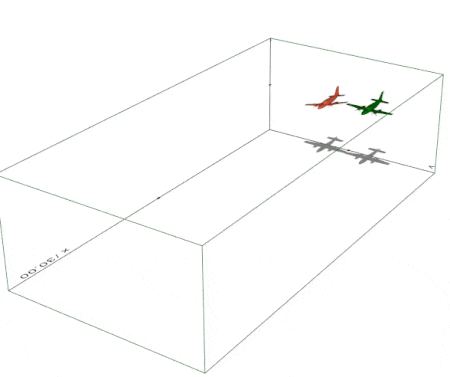 Create a simple 3D animation in exactly 10 lines of code (script). Trails and shadows can be added to moving objects easily. |
Simulation of a gyroscope hanging from a spring (script). |
 Quantum-tunnelling effect integrating the Schroedinger equation with 4th order Runge-Kutta method. The animation shows the evolution of a particle in a box hitting a sinusoidal potential barrier. (script) |
Visualizing a Turing system of reaction-diffusion between two molecules1 (script) 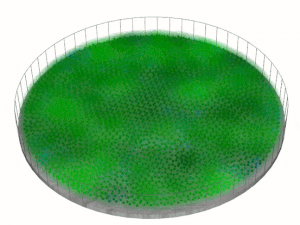 |
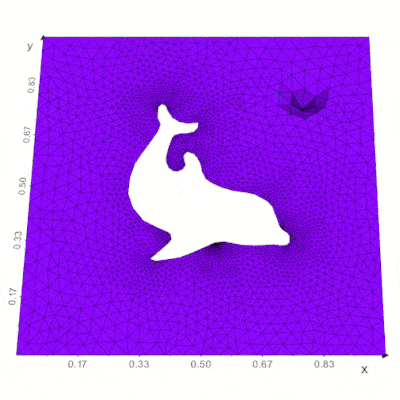 Support for the FEniCS/Dolfin platform for visualization of PDE and finite element solutions (see here) |
-
M. Musy, G. Dalmasso, J. Sharpe and N. Sime, "
vtkplotter: plotting in FEniCS with python", (link). Poster at the FEniCS'2019 Conference, Carnegie Institution for Science Department of Terrestrial Magnetism, Washington DC, June 2019. -
G. Dalmasso, "Evolution in space and time of 3D volumetric images". Talk at the Conference for Image-based Modeling and Simulation of Morphogenesis. Max Planck Institute for the Physics of Complex Systems, Dresden, Germany, March 2019.
Scientific publications using vtkplotter so far:
- X. Diego et al.: "Key features of Turing systems are determined purely by network topology", Physical Review X, 20 June 2018.
- M. Musy, K. Flaherty et al.: "A Quantitative Method for Staging Mouse Limb Embryos based on Limb Morphometry", Development, 5 April 2018, doi: 10.1242/dev.154856.
- G. Dalmasso et al., "Evolution in space and time of 3D volumetric images", in preparation.
Have you found this software useful for your research? Please cite it as:
M. Musy et al.
"vtkplotter, a python module for scientific visualization and analysis of 3D objects
and point clouds based on VTK (Visualization Toolkit)",
Zenodo, 10 February 2019, doi: 10.5281/zenodo.2561402.
